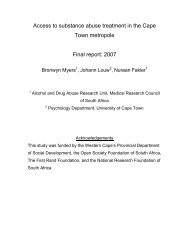Audit of Substance Abuse Treatment Facilities in ... - SA HealthInfo
Audit of Substance Abuse Treatment Facilities in ... - SA HealthInfo
Audit of Substance Abuse Treatment Facilities in ... - SA HealthInfo
- No tags were found...
Create successful ePaper yourself
Turn your PDF publications into a flip-book with our unique Google optimized e-Paper software.
treatment facilities <strong>in</strong> Cape Town (Myers & Parry, 2003); Gauteng (Myers, 2004) andGauteng and KwaZulu-Natal (Myers & Fakier, 2007). If <strong>in</strong>equities <strong>in</strong> treatment serviceutilisation are to be addressed, these barriers need to be targeted as a matter <strong>of</strong> urgency.4.3.3. Target<strong>in</strong>g barriers to treatment retention: The appropriateness <strong>of</strong> servicesIn South Africa few facilities provide age, gender and culturally sensitive treatmentprogrammes (Myers & Parry, 2003; Myers, 2004). This is a concern as the absence <strong>of</strong>appropriate services for groups such as women and cultural m<strong>in</strong>orities and concernsabout the cultural and gender appropriateness <strong>of</strong> services have been identified as barriersto substance abuse treatment utilisation (Appel et al., 2004; Tucker, Vuch<strong>in</strong>ich, &Rippens, 2004). The follow<strong>in</strong>g sections describe the extent to which treatment facilitiesprovide culturally, gender and age-sensitive treatment services.Cultural and l<strong>in</strong>guistic appropriateness <strong>of</strong> servicesConcerns about the cultural and l<strong>in</strong>guistic appropriateness <strong>of</strong> South African treatmentservices have also been an obstacle to treatment retention for clients from underservedgroups, particularly Black/African substance abusers. This study found that although allfacilities report provid<strong>in</strong>g treatment programmes <strong>in</strong> multiple languages, a smallerproportion <strong>of</strong> facilities provide counsell<strong>in</strong>g that is culturally-appropriate, use culturallyappropriateassessment tools, and translate programme materials <strong>in</strong>to multiple languages.These factors potentially <strong>in</strong>hibit Black/African persons from be<strong>in</strong>g reta<strong>in</strong>ed <strong>in</strong> treatment,with Black/African clients be<strong>in</strong>g more likely to rema<strong>in</strong> <strong>in</strong> facilities that provide culturaland l<strong>in</strong>guistically appropriate services. Although treatment facilities may serve a higherproportion <strong>of</strong> Black/African clients because they attempt to ensure that their services areculturally and l<strong>in</strong>guistically appropriate, it is also possible that certa<strong>in</strong> facilities exam<strong>in</strong>ethe appropriateness <strong>of</strong> their services because a high proportion <strong>of</strong> their clientele areBlack/African. To fully understand these f<strong>in</strong>d<strong>in</strong>gs, further <strong>in</strong>vestigation <strong>in</strong>to therelationships among demographic pr<strong>of</strong>ile, treatment needs, and factors facilitat<strong>in</strong>gtreatment retention for recipients <strong>of</strong> substance abuse treatment is required.In summary, this study suggests that the demographic pr<strong>of</strong>ile <strong>of</strong> persons seek<strong>in</strong>gtreatment may <strong>in</strong>fluence whether facilities provide culturally and l<strong>in</strong>guistically74
















